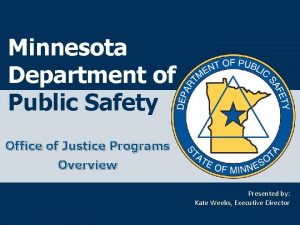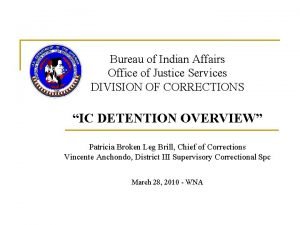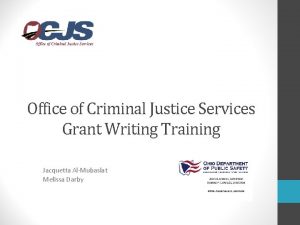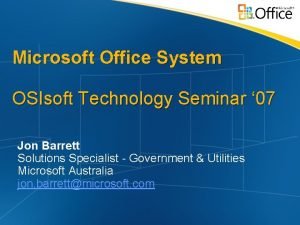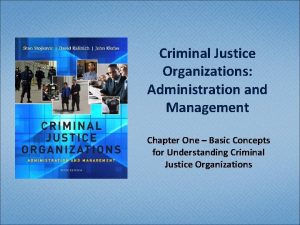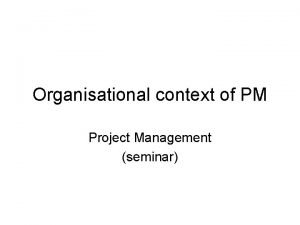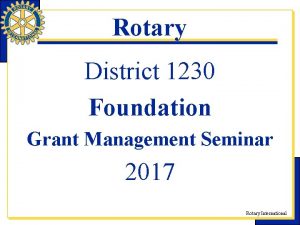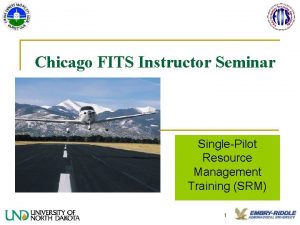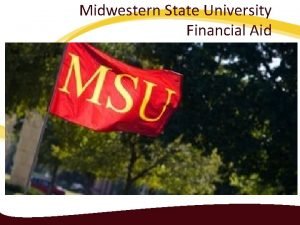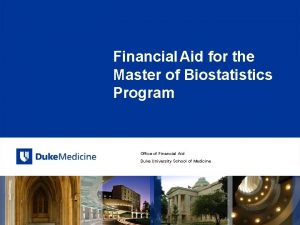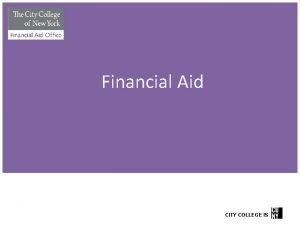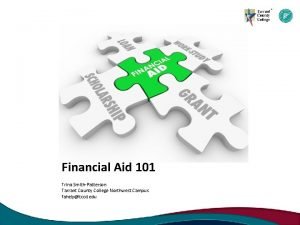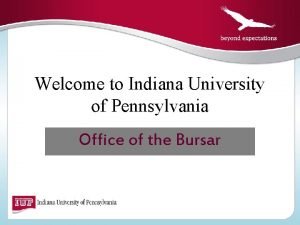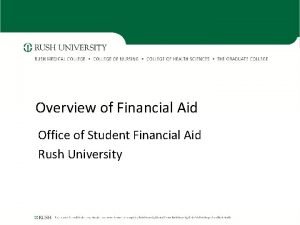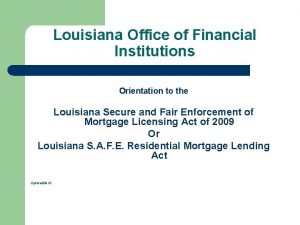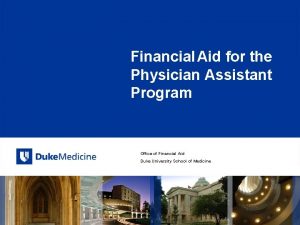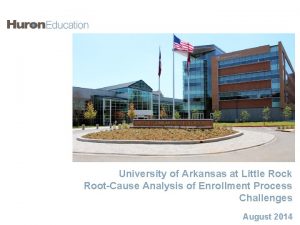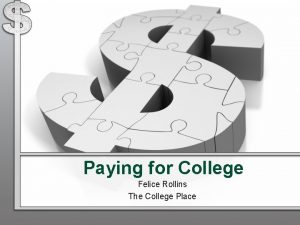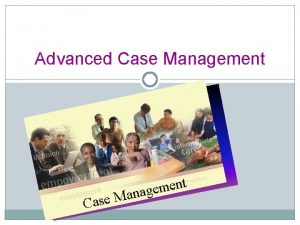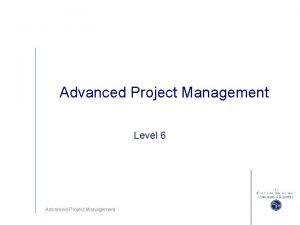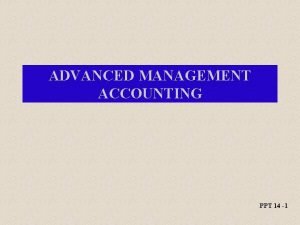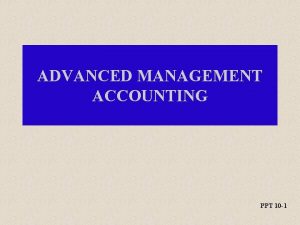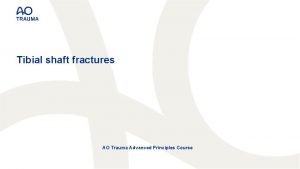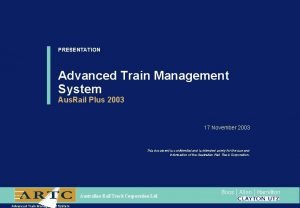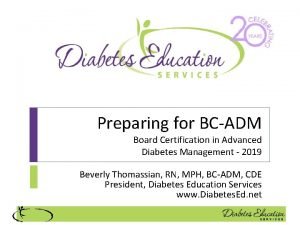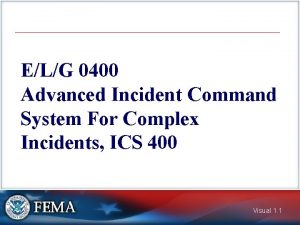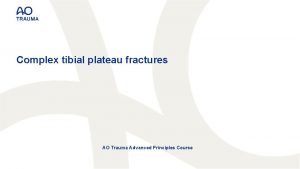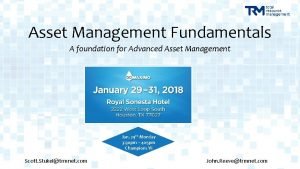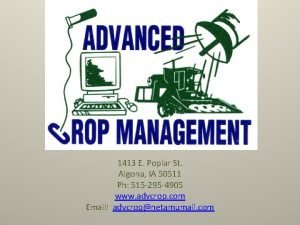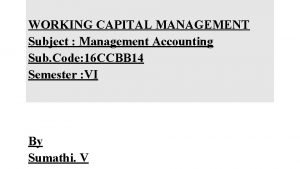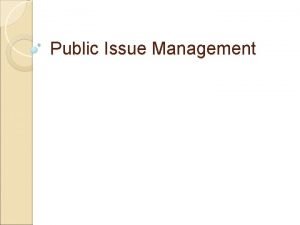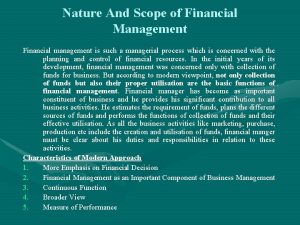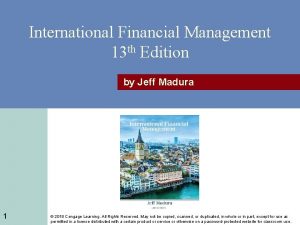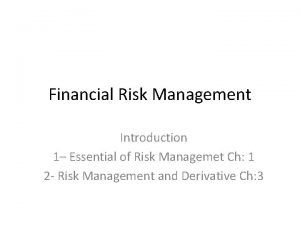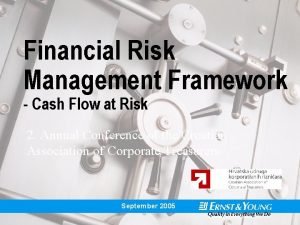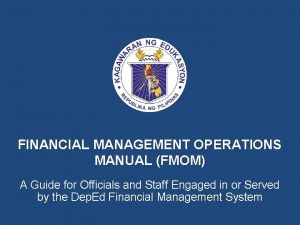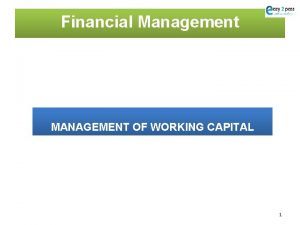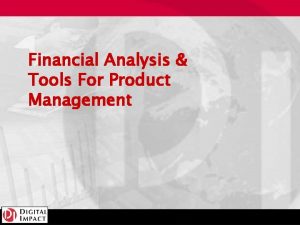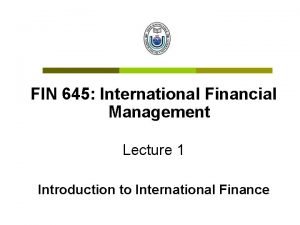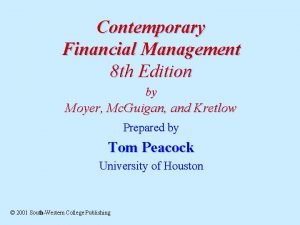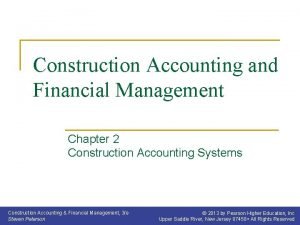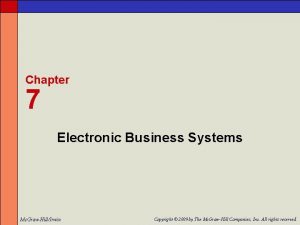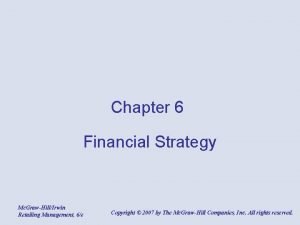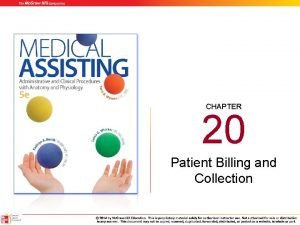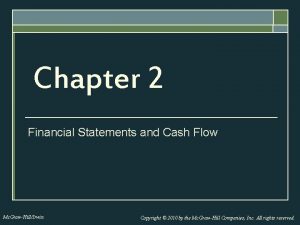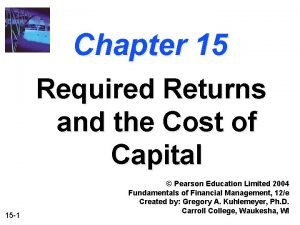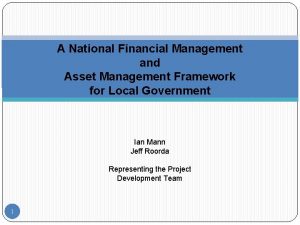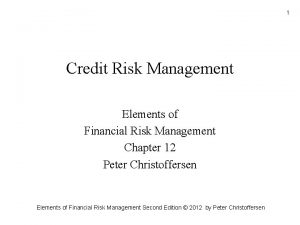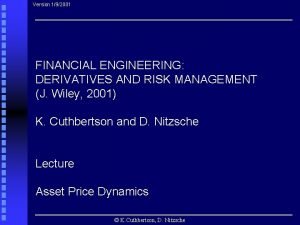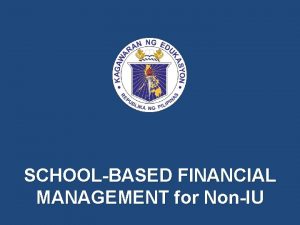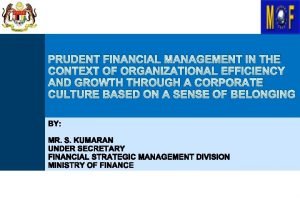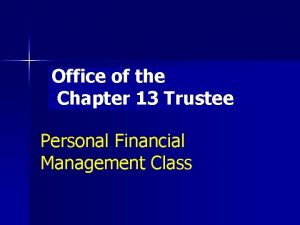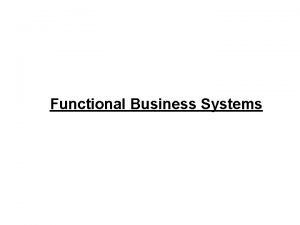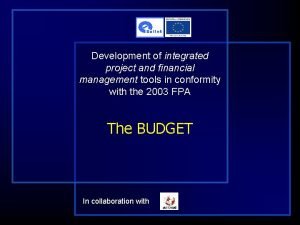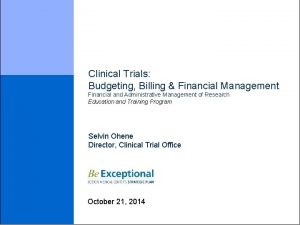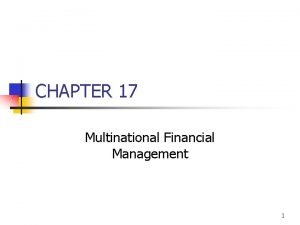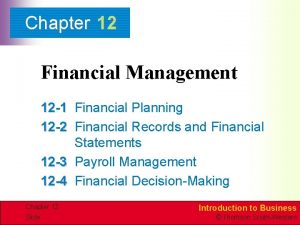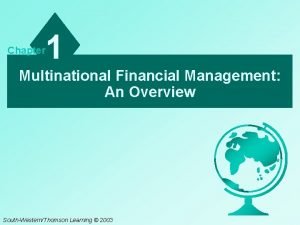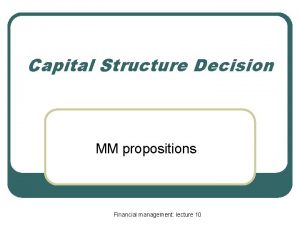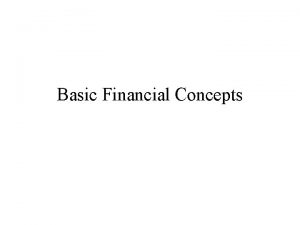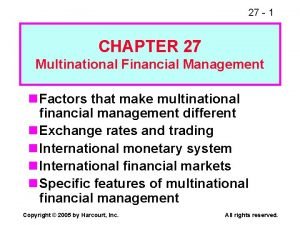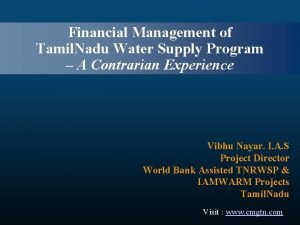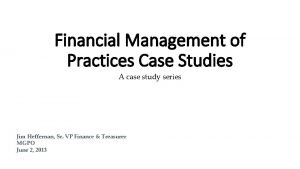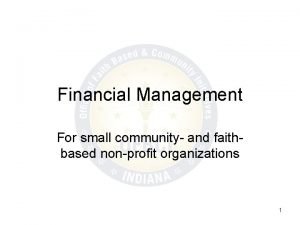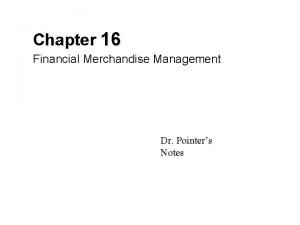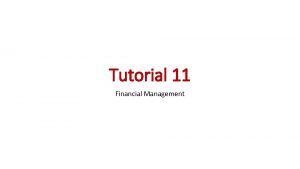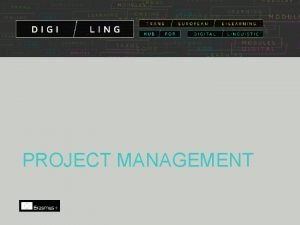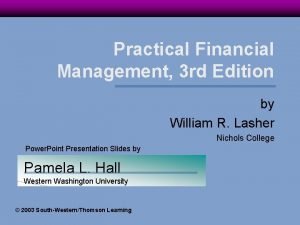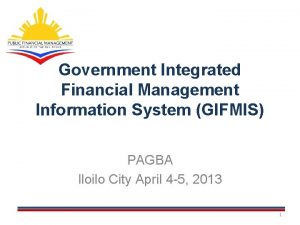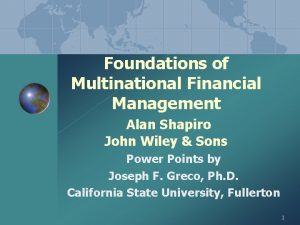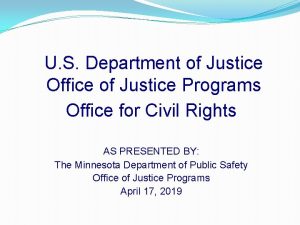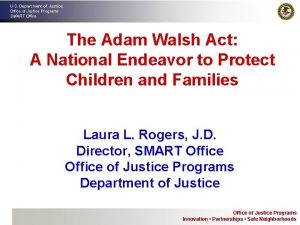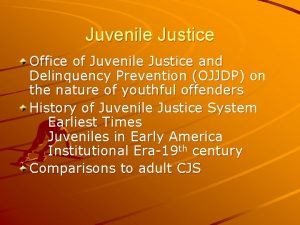Seminar on Advanced Financial Management Office of Justice









































































































































- Slides: 137

Seminar on Advanced Financial Management Office of Justice Programs Office of the Chief Financial Officer

Welcome & Introductions

Introduction 1. Name/Title 2. Agency represented 3. Years in grants 4. Expectations

Learning Objectives • Purpose Financial Monitoring Review • Types of Financial Monitoring Reviews ü Desk Reviews ü On-Site Reviews • How are desk and onsite reviews selected ü Risk Assessment • Performing a desk review • Preparing for and Performing an on-site review • Follow Up on Recommendations • Common Findings • Suggestions for mitigating Findings 4

Office of the Chief Financial Officer Leigh Benda Chief Financial Officer Vacant Deputy Chief Financial Officer Finance, Accounting and Analysis Division Grants Financial Management Division Financial Systems Support Division Management, Audit and Admin Team Strategic Planning and Performance Division Budget Formulation and Appropriation Division Budget Execution Division 5

Grants Financial Management Division (GFMD) 6

Financial Monitoring Review The Preparation and Performance 7

Purpose of Financial Monitoring Review • Ensure grantee’s accounting system, policies and procedures, and financial records are adequate to administer federal funds; • Ensure grantee have the necessary Internal controls in place to safeguard against fraud, waste, and abuse; • Assess compliance with program and federal guidelines; • Provide technical assistance; and • Make recommendations for improvement. 8

Definitions • Limited Scope Review – a review of financial information, policies and procedures, and internal controls, to ensure validity and accuracy of reported information, and compliance with Federal Requirements. The process does not warrant an opinion. 9

Definitions (cont) • Audit -is an objective examination and evaluation of an entity’s financial statements and accompanying disclosures by an independent auditor. The result of this examination is a report by the auditor, attesting to the fair presentation of the financial statements and related disclosure. The process warrants an expression of an opinion. 10

Types of Financial Monitoring Reviews Desk Review: ü Monitoring review at desk On-Site Review: ü Monitoring review at grantee’s site 11

Risk Assessment • Develop a plan (annually). • The plan should identify the potential risk factors posed by the entire population of grants. • Utilized 38 attributes in FY 2019. Factors may include: ✓ New grantee; ✓ Dollar amount of award; ✓ Confidential/Matching funds; ✓ Program income; ✓ Timeliness of reports; ✓ Subawards 12

Risk Assessment Tool Construct a weighted matrix to define the level of risk for each factor. Weight 1 2 3 Means Low Risk Moderate Risk Higher Risk 13

Risk Assessment Tool (cont) Each risk factor can be further evaluated for its relative importance. Weight 1 2 3 Means Low Importance Moderate Importance Higher Importance 14

Risk Assessment Tool (cont) • The final score is the result of multiplying the Risk score by the Importance score. ✓ For example, an attribute designated as moderate-risk received a Risk score of (2) and an Importance score of (2) • The total score for that attribute would be (4). Weight Means 2 Moderate Risk 2 Moderate Importance 15

Types of Desk Review • • Standard Enhanced Restricted Drawdowns Conference Costs 16

Standard Desk Review • Send a questionnaire form to FPOC to complete and return to OCFO for review • Financial Monitor will complete a Desk Review Checklist to ensure compliance with Federal regulations and program guidelines • Financial Monitor may contact the grantee for additional information or to remedy an issue, if needed • Grantee will receive an email indicating that the desk review is closed

Enhanced Desk Review • Request and review accounting records (i. e. , general ledger, budget vs. actuals, selected policies & procedures, audit report, etc. ) • Sample testing/source documentation from grantee ✓ Select expenditure transactions for testing ✓ Request supporting documentation ✓ Review documentation • Grantee will receive an email indicating that the desk review is closed

Restricted Drawdown • Designated for high risk grantees • Evaluating the grantees monthly or quarterly request for funds • Sample testing/source documentation from grantee ✓ Select expenditure transactions for testing ✓ Request supporting documentation ✓ Review documentation ✓ Recommend amount of funds to be released ✓ Final approval is with OAAM

Conference Costs • Excess cash review • Pre-Approval and post-event reporting • Sample testing/source documentation from grantee ✓ Select expenditure transactions for testing ✓ Request and review supporting documentation • Financial Monitor may contact the grantee for additional information or to remedy an issue, if needed • Grantee will receive an email indicating that the desk review is closed

Pre-Site Review • • Coordinate dates with program offices Confirm dates with grantee Notify US Attorney’s Office Send out confirmation letter to grantee (email & GMS) and request specific documents ✓ Detailed General Ledger (G/L) accounts of all expenditures incurred as of a specified date (i. e. , March 31, 20 XX) for all grants - (preferably in excel format) ✓ A summary of all expenditures incurred, as of a specified date, by approved budget categories or spending plan (preferably in excel format) 21

Pre-Site Review (cont) Confirmation letter and request documents (cont) • Copy of most recent Single Audit Report • Policies and procedures • Chart of accounts (help to compare budget to actual) ü Current Assets (10000 – 16999) ü Property, Plant, and Equipment (17000 – 18999) ü Current Liabilities (20020 – 24999) ü Operating Revenues (30000 – 39999) • List of employees compensated with grant funds 22

Pre-Site Review (cont) Confirmation letter and specific documents (cont) • Inventory list of equipment purchased with grant funds • List of conferences held funded with DOJ funds • List of sole source procurements with justifications and approvals • List of all subrecipients • Source of matching funds • Amount and source of program income • Agency’s organizational chart 23

Pre-Site Review (cont) Complete a pre-site visit review of documents currently in our systems (i. e. , GMS, GPRS, etc. ): • Federal Financial Reports (FFRs) • Progress Reports • Indirect Cost Agreements (if expired request a current copy while on site) • Application narrative • Budget and Budget narrative • Financial Clearance Memo (FCM) – (equivalent to OCFO letter) 24

Pre-Site Review (cont) Complete a pre-site visit review of documents currently in other Federal systems (i. e. , SAM, FAC, FSRS, etc. ) • Single Audit compliance ✓ Timeliness of audit submission ✓ If not applicable, request certification from grantee justifying that they are exempt • SAM Registration ✓ Not expired • FFATA Reporting ✓ Check FSRS for a list of subawards reported by grantee 25

Pre-Site Review (cont) • Check list of subrecipients against what was reported in Federal Funding Accountability and Transparency Act Subaward Reporting System (FSRS) 26

Pre-Site Review (cont) Complete a pre-site visit review of documents received from the grantee: • Adequacy of written policies and procedures ✓ Accounting Procedures o o o Receipts and expenditures of grant funds Process for submitting required reports Request grant funds Staff responsibilities Cash management policy 27

Pre-Site Review (cont) • Adequacy of written policies and procedures (cont) ✓ Payroll/Time and Attendance o Activity/time attendance reports o Actual hours vs Budget o Signed by the employee and approved by an authorized official 28

Pre-Site Review (cont) • Adequacy of written policies and procedures (cont) ✓ Procurement Procedures o Specific steps to follow to purchase good and services − Approvals (i. e. , consultant rate) − Purchase orders − Competition − Non competitive Proposals (Sole source) o Contract Administration − Monitor the actual contract and progress − Ensure products and/or services meet all requirements 29

Pre-Site Review (cont) • Adequacy of written policies and procedures (cont) ✓ Travel Procedures o o Authorizations and approvals Lodging and per diem rates Provisions for in-state and out-of-state travel Travel vouchers Note: No policy - must follow Federal Travel Regulation 30

Pre-Site Review (cont) • Adequacy of written policies and procedures (cont) ✓ Non-Expendable Property and Equipment o Property records − A description of the item − Serial number − Cost (source of funding) − Acquisition date − Location of item o Physical inventory − Conduct at least once every two years o Disposition − $5000 or more, contact awarding agency 31

Pre-Site Review (cont) Reconciliation of Accounting Records vs FFRs

Pre-Site Review (cont) Reconciliation of Accounting Records vs. FFRs • Reconcile cumulative expenditures for a specified period for grant with cumulative expenditures reported on FFR ✓ FFR does not reconcile to accounting records, the difference will be questioned

Pre-Site Review (cont) Cash Management Analysis Accounting records Drawdowns vs. Transaction Obligation Date Amount Payment Amount Balance 09/16/2015 $350, 000. 00 04/11/2016 $0. 00 $7, 475. 64 $342, 524. 36 08/01/2016 $0. 00 $18, 379. 89 $324, 144. 47 08/22/2016 $0. 00 $2, 550. 55 $321, 593. 92

Pre-Site Review (cont) Budget vs Actual Expenditures

Pre-Site Review (cont) Budget vs Actual Expenditures To Determine the Budget to Actuals for Personnel and Fringe: 1. Check to see which account codes belong to Personnel (Salary and Wages) 2. Account code for Personnel is 1000 and Fringe Benefits is 1050 3. Total all costs associated with the Personnel account codes 4. Personnel total is $180, 000 Total all costs associated with the Fringe account codes Fringe Benefits total is $31, 770 36

Pre-Site Review (cont) Budget vs. Actual Expenditures Budget to Actuals Table: The Results: $58, 000 + $62, 000 + $60, 000 = 180, 000 37

Pre-Site Review (cont) Budget vs. Actual Expenditures Discretionary Grant and Budget Categories/Purpose Area 2018 -XX-XX-XXXX Personnel Approved Budget Percentage of Actual Available Balance Budget Expenditures (Deficit) of Budget Expended $400, 000. 00 $180, 000. 00 $220, 000. 00 45% Fringe Benefits $70, 600. 00 $2, 689 $67, 911. 00 4% Travel $66, 090. 00 $40, 097. 24 $25, 992. 76 61% Equipment $15, 087. 00 $16, 230. 00 ($1, 143. 00) 108% $0. 00 $153. 62 ($153. 62) -100% $202, 946. 00 $62, 798. 62 $140, 147. 38 31% $3, 837. 00 $2, 124. 45 $1, 712. 55 55% $80, 000. 00 $36, 000. 00 $44, 000. 00 45% $838, 560. 00 $340, 092. 93 $498, 467. 07 41% Supplies Contractual Other Indirect Costs Total Project Costs

Pre-Site Review (cont) Budget vs Actual Expenditures Formula Grant and Budget Categories/Purpose Area 2018 -XX-XX-XXXX Approved Budget Available Balance (Deficit) of Budget Actual Expenditures Percentage of Budget Expended $145, 853 $86, 234 $59, 619. 00 59% $402, 387 $232, 452 $169, 935. 00 58% $205, 600 $148, 623 $56, 977. 00 72% Drug treatment and enforcement program $356, 458 $301, 200 $55, 258. 00 84% Crime victim and witness programs $348, 234 $289, 464 $58, 770. 00 83% $1, 458, 532 $1, 057, 973 $400, 559. 00 73% Administration Law Enforcement Programs Prosecution and Court Programs Total Direct Costs

Pre-Site Review (cont) • Single Audit Report – Results of previous audits performed 40

Pre-Site Review (cont) • Single Audit Report ü Whether a DOJ program was identified as a major program − Were there any findings • Cross cutting issues • Timely submission 41

Pre-Site Review (cont) • Select samples from detail general ledger transactions XYZ County 42

On-Site Review • Conduct Entrance Conference • Assess Internal Controls • Determine Adequacy of Financial Management System • Test and Analyze Expenditures • Conduct Exit Conference 43

On-Site Review (cont) Entrance conference • Discuss objectives of site visit with key personnel • Discuss concerns noted during the pre-site visit work

On-Site Review (cont) Assess Internal Controls • A process implemented by a non-Federal entity, designed to provide reasonable assurance regarding the achievement of objectives in the following categories: ü Effectiveness and efficiency of operations; ü Reliability of reporting for internal and external use; and ü Compliance with applicable laws and regulations. • Necessary to prevent fraud, waste, and abuse 45

On-Site Review (cont) Basic Internal Control Principles Develop and implement procedures • Time & attendance, travel, procurement, fixed asset and inventory, Federal grants management, subrecipient monitoring Establish responsibility • Assign each task to only one person Segregate duties • Don’t make one employee responsible for all parts of a process Restrict access • Don’t provide access to systems, information, assets, etc. unless needed to complete assigned responsibilities Independently verify • Check others’ work

On-Site Review (cont) Assess Internal Controls • Obtain understanding of controls through Inquiries/Interviews • Walkthroughs procedures with grantees • Verify existing controls 47

On-Site Review (cont) Adequacy of Financial Management Systems • Track grant expenditures separately by approved budget categories or purpose areas (i. e. , program income, match, conference cost) • Grant funds should not be commingled with other funds • Ability to accurately produce required financial reports

On-Site Review (cont) Types of questioned costs • • Unauthorized Unsupported Unreasonable Unallowable

On-Site Review (cont) Approved Budget

On-Site Review (cont) PERSONNEL • Detailed general ledger accounts • Payroll ledger/Labor distribution reports • Time and Attendance/Activity Reports ü Based on Actual hours worked on the grant • Rate of pay reasonable and allocable Cost must be necessary, reasonable, allowable, and allocable

Verify and trace payroll register amount to the time and attendance

On-Site Review (cont) Frequent Monitoring Findings Personnel • Staff timesheets/records not signed/certified by individual or supervisor • Staff time not properly documented • Staff time not properly allocated to various activities 53

On-Site Review (cont) Frequent Monitoring Findings Personnel (cont) • Charges and costs not based on actual afterthe-fact records, but on budgeted or preestablished amounts or percentages • Did not maintain certification for employees working 100% on the grant • Not in the approved budget 54

On-Site Review (cont) FRINGE BENEFITS • A Separate line item (not included in salaries) • Type of rate ü Approved fringe benefit rate, if applicable ü Breakdown – (i. e. , FICA, health, retirement, workman’s comp) • Proportionate to salaries Cost must be necessary, reasonable, allowable, and allocable

On-Site Review (cont) Frequent Monitoring Findings Fringe Benefits • Not proportionate with salaries • Fringe benefits not clearly defined (i. e. FICA, health insurance, retirement, etc. ) • Excessive fringe for executives • Not in the approved budget 56

On-Site Review (cont) TRAVEL • Travel Authorizations ü ü Purpose of trip Relation to project Approved in the budget Approval of authorizing official • Travel Voucher ü ü Timely submission Receipts Cost must be necessary, reasonable, allowable, and allocable

On-Site Review (cont) Frequent Monitoring Findings TRAVEL • Premium travel without prior approval from awarding agency • Excessive lodging/per diem charges • Unreasonable costs (i. e. early bird check in, premium sitting, etc) • Fines and penalties • Not in the approved budget 58

On-Site Review (cont) EQUIPMENT • Purpose/relevance to the project • Lease vs. purchase analysis (vehicles & large items) • Procurement process ü ü Capitalization threshold Competition • Inventory/property records • Physical inventory Cost must be necessary, reasonable, allowable, and allocable

On-Site Review (cont) Frequent Monitoring Findings EQUIPMENT • Unable to identify Federally purchased equipment • Inventory list/property records not maintained or inadequate • Physical inventory not conducted • Not in the approved budget 60

On-Site Review (cont) SUPPLIES • Relevance to project • Approved in the budget Cost must be necessary, reasonable, allowable, and allocable

On-site Review (cont) Frequent Monitoring Findings SUPPLIES • Inadequate documentation • Not in the approved budget • Unallowable costs 62

On-Site Review (cont) CONTRACTUALS • Procurement process ü Competitively bid ü Sole Source (threshold approvals) ü Consultants (threshold approvals) • Excluded Parties List System Cost must be necessary, reasonable, allowable, and allocable

On-Site Review (cont) CONTRACTUALS • Signed Contract ü Scope of work ü Payment terms ü Deliverables • Supplement awards, if applicable Cost must be necessary, reasonable, allowable, and allocable

On-Site Review (cont) Frequent Monitoring Findings CONTRACTUAL • Contractual and consultants agreements were not maintained • Consulting rate exceeds maximum allowed (no prior approval) • No sole source approval for contracts over $250, 000 • Work performed not in line with program goals • Conflict of interest • Not in the approved budget 65

On-Site Review (cont) OTHER • Relevance to the project • Approved in the budget Cost must be necessary, reasonable, allowable, and allocable

On-Site Review (cont) Frequent Monitoring Findings OTHER • Inadequate documentation • Not in the approved budget • Unallowable costs 67

On-Site Review (cont) INDIRECT COSTS • Current approved negotiated agreement or approved Cost Allocation Plan • Application of approved rate, if applicable (to include base) • Election of De Minimis Rate (based on MTDC) • Indirect cost budget not exceeded • Recorded in accounting system • Reported on Federal Financial Report (FFR) Cost must be necessary, reasonable, allowable, and allocable

On-Site Review (cont) Frequent Monitoring Findings INDIRECT COSTS • Expired and/or no current approved indirect cost agreement • Not in the budget or exceeded approved budget • Indirect costs not properly allocated • Not recorded in accounting system 69

On-Site Review (cont) Frequent Monitoring Findings INDIRECT COSTS (cont) • Not reported on FFR • Indirect costs recorded in accounting system do not reconcile with amounts reported on FFR • Direct costs recorded as indirect costs 70

On-Site Review (cont) CONFERENCE COSTS • Written policies and procedures • Tracked separately in the grantee’s accounting system • Prior approvals • Post event reporting Cost must be necessary, reasonable, allowable, and allocable

On-Site Review (cont) Frequent Monitoring Findings CONFERENCE COSTS • No written policies and procedures • Not tracked separately within accounting system • No Prior approvals • Post even reports not maintained 72

On-Site Review (cont) Frequent Monitoring Findings Conference Costs (cont) • • Exceed budget Exceeded threshold limitations ü Conference Space & AV-Equipment - $25 per day per attendee, not to exceed $20, 000. ü Logistical Conference Planner - $50 for each attendee, not to exceed $8, 750 ü Programmatic Conference Planner - $200 for each attendee, not to exceed $35, 000 • Unallowable costs ü Trinkets ü Food and beverages (unless prior approval is obtained)

On-Site Review (cont) Subrecipient and Contractor Determinations (Title 2 CFR 200) Subrecipients. A subaward is for the purpose of carrying out a portion of a Federal award and creates a Federal assistance relationship with the subrecipient. Characteristics which support the classification of the non. Federal entity as a subrecipient include when the non-Federal entity: 1) Determines who is eligible to receive what Federal assistance; 2) Has its performance measured in relation to whether objectives of a Federal program were met; 3) Has responsibility for programmatic decision making; 4) Is responsible for adherence to applicable Federal program requirements specified in the Federal award; and 5) In accordance with its agreement, uses the Federal funds to carry out a program for a public purpose specified in authorizing statute, as opposed to providing goods or services for the benefit of the passthrough entity. 74

On-Site Review (cont) Subrecipient and Contractor Determinations (Title 2 CFR 200) Contractors. A contract is for the purpose of obtaining goods and services for the non-Federal entity's own use and creates a procurement relationship with the contractor. Characteristics indicative of a procurement relationship between the non-Federal entity and a contractor are when the contractor: 1) 2) 3) 4) Provides the goods and services within normal business operations; Provides similar goods or services to many different purchasers; Normally operates in a competitive environment; Provides goods or services that are ancillary to the operation of the Federal program; and 5) Is not subject to compliance requirements of the Federal program as a result of the agreement, though similar requirements may apply for other reasons. 75

On-Site Review (cont) Pass-Through Entities’ Responsibilities • Subrecipient monitoring procedures – award, management, risk assessment, monitoring and closeout • Monitoring Plan • Results of monitoring • Follow up on issues identified during monitoring and resolution • Require each subrecipient to permit the passthrough entity and monitors/auditors to have access to the records and financial statements as necessary

On-Site Review (cont) Subrecipient File Documentation • Signed award agreement or Memo of Understanding (MOU) ü Grant award special conditions passed on to subrecipients • Approved Budget and budget modifications • Compliance with Single Audit reporting requirements • Progress Reports • Financial Reports • Evidence of monitoring and follow up

On-Site Review (cont) Frequent Monitoring Findings SUBRECIPIENT • No written guidelines in awarding, managing, and closing subawards • No Risk Assessment/Monitoring Plan • Inadequate monitoring/follow up • Excess cash-on-hand at subrecipient level • Subaward not related to program objectives • Subrecipients expenditures do not reconcile with accounting records. 78

On-Site Review (cont) Frequent Monitoring Findings SUBRECIPIENT (cont) • Subrecipient questioned costs • Conflict of interest • Program income not accounted for • Match not accounted for • Subaward not reported in FSRS 79

On-Site Review (cont) MATCH • Matching contributions are subject to audit • Match separately tracked in grantee’s accounting system • Identify source of match • Document match • If a recipient did not provide the required match by the end of the project period, an adjustment may be required and/or funds may have to be returned to OJP Cost must be necessary, reasonable, allowable, and allocable

On-Site Review (cont) Frequent Monitoring Findings MATCH • Source and timing of match not identified • Not properly documented, recorded, or tracked • Match not reported on FFR • Required match not met 81

On-Site Review (cont) PROGRAM INCOME • Activities that generate program income ü ü ü ü ü Interest earned on JAG and JABG grants Program income earned by subrecipients Registration/Tuition fees Sale of videos, publications, other media Rental/usage fees (DNA grants) Royalties Service Fees Membership Fees Seizures of asset Cost must be necessary, reasonable, allowable, and allocable

On-Site Review (cont) PROGRAM INCOME (cont) • Program income is subject to audit • Must be documented by recipient • Separately tracked in recipient’s accounting system • Reported on FFR cumulatively • Any program income earned during the project period and not utilized for the project must be refunded to the awarding agency Cost must be necessary, reasonable, allowable, and allocable

On-Site Review (cont) Frequent Monitoring Findings PROGRAM INCOME • Source of income not properly documented • Not accounted for in accounting system • Not reported on FFR 84

On-Site Review (cont) Compliance with Award Special Conditions The recipient agrees to comply with the financial and administrative requirements set forth in the current edition of the DOJ Grants Financial Guide. http: //www. ojp. gov/financialguide/doj/index/htm

On-Site Review Compliance with Award Special Conditions (cont) ……. The recipient may not obligate, expend or draw down funds until the Office of the Chief Financial Officer (OCFO) has approved the budget and budget narrative and a Grant Adjustment Notice (GAN) has been issued to remove this special Condition…

On-Site Review (cont) Compliance with Award Special Conditions (cont) • Dates of drawdowns • Expenditure dates • Obligation dates (subawards/contracts)

On-Site Review (cont) OTHER MONITORING FINDINGS • Administrative costs on Formula awards ü Exceeded threshold amounts • Budget modifications ü Exceeded 10% of the award amount ü Change in scope ü Zero budget category • Excess Cash • Weakness in internal controls • Possible Supplanting Cost must be necessary, reasonable, allowable, and allocable

Ten Top Monitoring Findings (FY 2018) 1. Procedures not documented or need improvement. 2. FFR do not reconcile to grantee’s accounting records. 3. FFATA reporting requirements not met. 4. Internal control weakness – procedures not followed. 5. Unsupported costs.

Ten Top Monitoring Findings (FY 2018) 6. 7. 8. 9. 10. Inadequate subrecipient documentation. Award special conditions violated. FFR not timely submitted. Excess cash-on-hand identified. Matching funds not accurately reported on FFR.

On-Site Review (cont) EXIT CONFERENCE • Discuss results of monitoring • Explain what will happen next • Provide resources (customer service number, website link of financial guide, online training, etc) 91

Site Review Follow up • Finalize site visit report documenting results of site visit • Share results of site visit with program offices and bureaus • Share results of site visit with our Office of Audit, Assessment, and Management (OAAM) if referring grantee for high risk designation • Send follow up letter to grantee identifying issues noted and recommendations to resolve any issues • Request Corrective Action Plan (CAP) from grantee within 30 days

Site Review Follow up (cont) CAP letter should include • Description of each finding • Specific steps to be taken to implement the recommendation • Timetable for performance of each corrective action • Description of monitoring to be performed to ensure implementation of the C A P

Site Review Follow up (cont) CAP received from grantee • Review CAP and additional documentation provided • Close recommendations based on adequacy of documents provided • Send partial closure or closure letter • Close site visit

Site Review Follow up (cont) If CAP letter not received • Send a first delinquent notice requesting response within 15 days • If no response received, send a second delinquent notice requesting response within 15 days • If no response received, a third and final delinquent notice signed by the Assistant CFO or designee is sent requesting response within 15 days

Site Review Follow up (cont) If CAP letter not received (cont) • If grantee does not respond within 15 days from the date of the final notice: ü Unresolved questioned costs – grantee shall be referred to U. S. Department of Treasury, for collection ü No questioned costs – may be referred for administrative closure and be subject to additional administrative actions

Resources • CFR 200 – (http: //www. ecfr. gov/cgi-bin/textidx? tpl=/ecfrbrowse/Title 02/2 cfr 200_main_02. tpl ) • 2017 DOJ Grants Financial Guide – (http: //ojp. gov/financialguide/doj/index. htm) • 2015 Guide to Procurements under DOJ Grants and Cooperative Agreements 97

Resources (cont) • Federal Travel Regulations (http: //www. gsa. gov/graphics/ogp/FTR 201102 Complete. pdf) • GAO Green Book – Standards for Internal Control in the Federal Government (http: //www. gao. gov/assets/670/665712. pdf) • COSO Internal Control Integrated Framework - help organizations design and implement internal control 98

COST ALLOCATION PLANS & INDIRECT COST RATE 99

OVERVIEW • Cost Allocation Plans (CAPs) and Indirect Cost Rates (IDC) • Indirect Cost Rate and Base • Indirect Cost Rate Calculations • Use of Indirect Cost Rates • Cognizant Agency and Submission Requirements • Common IDC Findings 100

Central Service Cost Allocation Plans • Central service cost allocation plan is the documentation identifying, accumulating, and allocating or developing billing rates based on the allowable costs of services provided by a governmental unit on a centralized basis to its department and agencies. (2 CFR Part 200. 9)

State-Wide Cost Allocation Plans (SWCAP) • Mechanism for the state to identify, summarize, and allocate statewide indirect costs • Allows state to charge cost of central services to federal awards • Should submit annual SWCAP to U. S. Department of Health and Human Services

Indirect and Direct Costs • Indirect Costs ü Indirect costs are those that have been incurred for common or joint objectives and cannot be readily identified with a particular final cost objective… ü Not readily assignable to the cost objectives for which the benefits were specifically assigned. • Direct Costs ü Costs that can be identified specifically with a final cost objective. 103

Administrative Cost Definition Administrative Costs – costs of general services (such as salaries, fringe benefits, accounting, office supplies, contracting, etc. ). Administrative costs can be direct or indirect.

Difference between Indirect & Direct Costs Indirect “Administrative” Salary, Related Occupancy Expenses, Supplies & Communication Accounting Executive Administration Operating Programs Human Resources Cost Policy Statement Federal Programs Non-Federal Programs Direct “Program” Salaries, Space Costs for Program Activities, Travel and Equipment 105

Types of Indirect Cost (IDC) Rates • • Fixed Carry-Forward Provisional Final Rate De Minimis

Types of IDC Rates ü Fixed Carry-Forward - A permanent rate established for a future prospective period of time used for budgeting, obligations, and payment of funds by awarding agencies. Actual costs are determined by the organization's accounting system and the difference between fixed and actual is carried forward to a future period (usually the organization's fiscal year) in order to adjust the fixed rate for any over or under recovery. 107

Types of IDC Rates (cont) • Provisional – temporary rates used for funding and billing indirect costs, pending the establishment of a final rate for a period. • Final Rate – means an indirect cost rate applicable to a specified past period which is based on the actual costs of the period. A final rate is not subject to adjustment. 108

Types of IDC Rates (cont) De Minimis Rate • Indirect cost rate of 10% of Modified Total Direct Cost (MTDC) • Electing to use the de minimis rate means an applicant does not have to submit a proposal for review. 109

Types of IDC Rates (cont) NOTE: • A final indirect cost rate is established after an organization's actual costs are known, typically a fiscal year. Once established, a final indirect cost rate is used to adjust the indirect costs claimed. • The use of provisional and final rates will likely result in final audited expenditures being higher or lower than those reported for awards, which are terminated during the organization's fiscal year. 110

Types of IDC Rates (cont) NOTE (cont): • A final rate may be issued as a provisional rate in the ensuing year, adjusted for anticipated changes in funding levels or costs. 111

Types of IDC Rates (cont) • One-time extension of a current negotiated rate for a period up to 4 years. ü Subject to approval from cognizant agency ü May not request a rate review until extension period ends ü Non-federal entity must reapply to negotiate new rate 112

Direct Cost “Base” and How it is Determined • Base is the accumulated direct costs used to distribute indirect costs to individual federal awards. It could be: ü Total direct salaries and wages, ü Total direct costs excluding distorting items o Capital expenditures o Pass-through funds o Major subcontracts o Unallowable costs 113

Direct Cost “Base” and How it is Determined (cont) • Selected base should result in each award bearing a fair share of the indirect costs in reasonable relation to the benefits received from the costs. 114

Types of Indirect Cost Base Modified Total Direct Costs Salaries and Wages

Base Used By DOJ/OJP • Total Direct Salaries and fringe benefits (Total Direct Labor) • Total Direct Salaries excluding fringe benefits • Modified Total Direct Cost (MTDC) all salaries and wages, fringe benefits, materials and supplies, services, travel and subawards (up to the first $25, 000). Equipment and capital expenditures are excluded.

Indirect Costs (IDC) Rate • A mechanism for determining the proportion of indirect cost each program should bear ü Percentage used to distribute indirect costs to all cost centers benefiting from activities associated with those costs. ü The % is derived by dividing indirect cost pool by direct cost base All Indirect Costs All Direct Costs X 100 = Indirect Costs Rate % 117

Indirect Costs Rate Calculation An indirect cost rate is simply a device for determining fairly and conveniently, within the boundaries of sound administrative principles, what proportion of indirect cost each program should bear. An indirect cost rate is the ratio, expressed as a percentage, of an indirect cost pool and some direct cost base. “Pool / Base = Rate” Indirect Cost Rate Indirect Costs $ 75, 000 Direct Costs Ø Salaries & Wages $ 150, 000 Ø Other Direct Costs $ 100, 000 Total Direct Costs Indirect Costs: $75, 000 Salaries & Wages: $150, 000 Indirect Costs: $75, 000 Total Direct Costs: $250, 000 $ 250, 000 50% Total Direct Labor (TDL) = 30% Total Direct Cost (TDC) = 118

Fixed Carried-Forward Rate per negotiation (FY) 2009: 16. 96% Rate per negotiation (FY) 2011: 29. 12% a) Direct cost base b)Actual Direct Expenditure 4, 341, 731, 758 Actual Indirect Expenditure Indirect Cost Pool: Department Indirect Costs 710, 630, 728 Department Indirect costs 710, 630, 728 SWCAP 289, 615, 842 Carry forward 263, 888, 864 Carry-Forward Total Pool -01, 000, 246, 570 Total Pool 1, 264, 135, 434 c) Carry-Forward calculations Recovered Rate x Actual Direct Costs 16. 96% x $4, 341, 731, 758 736, 357, 706 Should have recovered (Actual indirect costs for FY 09) 1, 000, 246, 570 Under (+) / Over (-) Recovery 263, 888, 864 119

For Budgeting Purposes • Total amount of federal award $200, 000 • Approved indirect cost rate 10% • Budgeted direct costs $181, 818 ($200, 000 / (1. 0 + 0. 10)) • Budgeted indirect costs $18, 182 ($181, 818 * 0. 1) 120

For Actual Expenditures • Actual direct costs $180, 500 • Approved indirect cost rate 10% Indirect costs charged to the project $18, 050 ($180, 500 x 10%) • 121

Be careful about the time period… • • The approved rate for FY 18 is to be used for ACTUAL expenditures from July 1, 2017 through June 30, 2018 Actual expenditures do not include outstanding encumbrances at year end 122

How to charge your federal project… • • Calculate the actual indirect costs based on actual expenditures (at least quarterly) The agency will make a journal entry to charge the indirect cost amount to each federal project as an expenditure

WHAT IS A COGNIZANT AGENCY? • • • The federal agency responsible for reviewing, negotiating, and approving cost allocation plans or indirect cost rate proposals developed under 2 CFR Part 200. 414. The cognizant agency negotiates on behalf of federal agencies and for non-profits, for-profits, and educational organizations. To obtain an indirect cost rate, a grantee must submit an indirect cost proposal to its cognizant agency and negotiate an indirect cost agreement.

Cognizant Agency Cognizant agency is the agency that provides the largest amount of direct funds to a grantee over a certain period of time. Department of Justice • Office of Justice Program (OJP) • Office of Violence Against Women (OVW) Department of • Health & Human Service Department of Interior Health & Human Service (HHS) • All American Indian Tribes

What are the Submission Requirements For Cost Allocation and Indirect Costs Rate Plans? • Cost Allocation Plans and Indirect Cost Rates must be: ü Developed and submitted within six months after the close of the entity’s fiscal year; ü Submitted as required by the cognizant agency; ü Inclusive of all units desiring to claim indirect costs; and ü Maintained on file if submission is not required. 126

Submitted Documentation should include: • • Indirect Cost Certification Organization chart Cost Policy Statement Audited Financial Reports (original sent to Federal Audit Clearinghouse) • Personnel Cost Worksheet (Non & For-Profit) or Signed Statewide Cost Allocation Plan (local Government) • Statement of Employee Benefit (Non & For Profit) or Fixed plus Carry Forward Calculation (local Government)

Submitted Documentation (cont) • Indirect Cost Rate Proposal(s) reconciled with the financial reports or budget • A list of grants showing source, amounts, and relevant dates • Itemized calculation supported by financial statement in cost pool and direct cost bases • Supporting documents for all adjustments • All Miscellaneous & Other expenses items in indirect cost MUST be itemized

Grantee Responsibilities • Grantees are responsible for ensuring that indirect costs are: ü Allowable, Reasonable, and Necessary; ü Treated consistently; ü In compliance with Generally Accepted Accounting Principles; ü Allocable to the federal program; ü Proportional to benefit received; and ü Adequately documented. 129

Examples of Generally Unallowable Indirect Costs Include: • • Contributions Entertainment costs Fund raising Lobbying Professional service costs Public information service costs Bad Debts Legal Costs

Common Indirect Cost Related Findings • Not having a current, approved Cost Allocation Plans or Indirect Cost Rates. • Using expired indirect cost rate. • Inconsistency in charging costs as direct or indirect between federal awards. • Costs that do not benefit the award are inappropriately allocated via the Indirect Cost Rate. 131

What are some of the Concerns OJP have about Grantee Submissions of Indirect Cost Rate Proposals? • Primary concern ü Incomplete documentation ü Indirect costs proposals do not provide sufficient detail to explain the functions and the benefits associated with the costs being allocated • Additional concern ü Indirect cost proposal that is not reconcilable to a budget or a financial statement and contains no explanation of the difference. 132

QUESTIONS AND ANSWERS

• CAN THE AUDIT COSTS UNDER 2 CFR 200 SUBPART F BE RECOVERED? 134

• HOW MANY DAYS DO WE HAVE TO SUBMIT A FINAL INDIRECT COST RATE PROPOSAL (BASED ON INCURRED COSTS)? 135

RESOURCES • Indirect Cost Submission Guidancehttps: //ojp. gov/funding/Apply/Resources/Indir ect. Costs. pdf • Indirect Cost Proposal Submissions- https: //ojp. gov/funding/Apply/Resources/Indir ect. Costs. pdf • DOJ Financial Guidehttps: //ojp. gov/financialguide/doj/pdfs/DOJ_F inancial. Guide. pdf 136

THE END THE END THE END
 Office of justice programs mn
Office of justice programs mn Office of justice services
Office of justice services Ohio office of criminal justice services
Ohio office of criminal justice services Microsoft office seminar
Microsoft office seminar Advanced manufacturing office
Advanced manufacturing office Management in criminal justice organizations
Management in criminal justice organizations Ana model of quality assurance
Ana model of quality assurance Performance management seminar
Performance management seminar Project management seminar
Project management seminar Maybo safer model
Maybo safer model Rotary district 1230
Rotary district 1230 Atlweather
Atlweather Non financial motivators
Non financial motivators Midwestern state university financial aid office
Midwestern state university financial aid office Fscj financial aid office
Fscj financial aid office Twu financial aid staff
Twu financial aid staff Fau net id
Fau net id Duke financial aid office
Duke financial aid office Csudh financial services
Csudh financial services Troy financial aid office
Troy financial aid office Columbia financial aid office
Columbia financial aid office Ccny financial aid office
Ccny financial aid office Tccd financial aid office
Tccd financial aid office Student health center chapman
Student health center chapman Auburn university student financial services
Auburn university student financial services Iup bursar office number
Iup bursar office number Dmacc web info
Dmacc web info Kent state financial aid
Kent state financial aid Rush financial aid office
Rush financial aid office Uwf financial aid disbursement dates
Uwf financial aid disbursement dates Algonquin college scholarships
Algonquin college scholarships University of louisville bursar's office
University of louisville bursar's office Detroit mercy admissions office
Detroit mercy admissions office Louisiana office of financial institutions
Louisiana office of financial institutions Simmons financial aid office
Simmons financial aid office William paterson financial aid office
William paterson financial aid office Financial aid longwood
Financial aid longwood Baylor financial aid office
Baylor financial aid office Duke pa school tuition
Duke pa school tuition Usi financial aid office
Usi financial aid office Usda office of the chief financial officer
Usda office of the chief financial officer Ualr financial aid office
Ualr financial aid office Fafsav
Fafsav Marshall university financial aid phone number
Marshall university financial aid phone number Linfield college financial aid
Linfield college financial aid Suny fredonia financial aid
Suny fredonia financial aid Office and factory
Office and factory Microsoft desktop optimization pack 2018 download
Microsoft desktop optimization pack 2018 download Advanced farm management
Advanced farm management Advance case management
Advance case management Maylor four stage model
Maylor four stage model Introduction to cost accounting ppt
Introduction to cost accounting ppt Advanced cost and management accounting ppt
Advanced cost and management accounting ppt Ao trauma
Ao trauma Advanced certificate management studies
Advanced certificate management studies Advanced train management system
Advanced train management system Advanced principles of fracture management
Advanced principles of fracture management Directions
Directions Advanced fms & security services pvt ltd
Advanced fms & security services pvt ltd Bc-adm practice exam
Bc-adm practice exam Ics 400: advanced ics for complex incidents-aberdeen
Ics 400: advanced ics for complex incidents-aberdeen Advanced principles of fracture management
Advanced principles of fracture management Asset management roadmap
Asset management roadmap Advanced environmental management
Advanced environmental management Poplar st sample
Poplar st sample Top management and middle management
Top management and middle management Top management middle management first line management
Top management middle management first line management Middle level management
Middle level management Management accounting subject code
Management accounting subject code Financial strategy in retailing
Financial strategy in retailing What is public issue
What is public issue Strategic financial management definition
Strategic financial management definition Approach of financial management
Approach of financial management Management of financial institutions daibb pdf
Management of financial institutions daibb pdf Six phases of public financial management
Six phases of public financial management International financial management jeff madura ppt
International financial management jeff madura ppt Risk management irrelevance proposition
Risk management irrelevance proposition Cash flow risk management
Cash flow risk management Deped financial management operations manual ppt
Deped financial management operations manual ppt What is working capital in financial management
What is working capital in financial management Meaning of financial management
Meaning of financial management Financial management theory
Financial management theory Modern approach of financial management
Modern approach of financial management Definition of financial management
Definition of financial management Financial analysis of product management
Financial analysis of product management Financial management lecture
Financial management lecture Financial performance management fpm
Financial performance management fpm Contemporary financial management
Contemporary financial management Construction accounting terms
Construction accounting terms Financial management chapter 8 risk and return
Financial management chapter 8 risk and return Financial management systems examples
Financial management systems examples Retail financial strategy
Retail financial strategy Chapter 20 patient collections and financial management
Chapter 20 patient collections and financial management 2-2 journal: financial statements and cash flow management
2-2 journal: financial statements and cash flow management Cost of capital in financial management
Cost of capital in financial management American academy of financial management
American academy of financial management National financial management
National financial management What is working capital in financial management
What is working capital in financial management Christoffersen elements of financial risk management
Christoffersen elements of financial risk management Financial engineering derivatives and risk management
Financial engineering derivatives and risk management School based financial management
School based financial management Prudent financial management practices
Prudent financial management practices Chapter 13 personal financial management course
Chapter 13 personal financial management course Expanded opportunity set international finance
Expanded opportunity set international finance Functional business systems
Functional business systems Financial risk management syllabus
Financial risk management syllabus Project financial management tools
Project financial management tools Clinical trial financial management
Clinical trial financial management Multinational financial management requires that
Multinational financial management requires that Chapter 12 financial management
Chapter 12 financial management Multinational financial management an overview
Multinational financial management an overview Profit maximization in financial management
Profit maximization in financial management M&m propositions
M&m propositions Key concepts of management
Key concepts of management Conclusion of financial management
Conclusion of financial management Multinational financial management requires that
Multinational financial management requires that Investment decision financing decision dividend decision
Investment decision financing decision dividend decision International financial management definition
International financial management definition Financial management oxford fajar
Financial management oxford fajar Vibhu nayar ias
Vibhu nayar ias Financial management case studies
Financial management case studies Financial management software for faith-based organizations
Financial management software for faith-based organizations Overview of financial management
Overview of financial management Enterprise risk management for financial institutions
Enterprise risk management for financial institutions Chapter 16 money management and financial planning
Chapter 16 money management and financial planning Chapter 16 money management and financial planning
Chapter 16 money management and financial planning Financial merchandise management
Financial merchandise management Financial merchandise management
Financial merchandise management Money management cycle
Money management cycle Financial management tutorial
Financial management tutorial Financial risk management conference 2018
Financial risk management conference 2018 Project management financial reporting
Project management financial reporting Practical financial management
Practical financial management Pearson my finance lab
Pearson my finance lab Monitoring fee
Monitoring fee Key risk indicators for vendor management
Key risk indicators for vendor management Gifmis portal
Gifmis portal Foundations of multinational financial management
Foundations of multinational financial management
